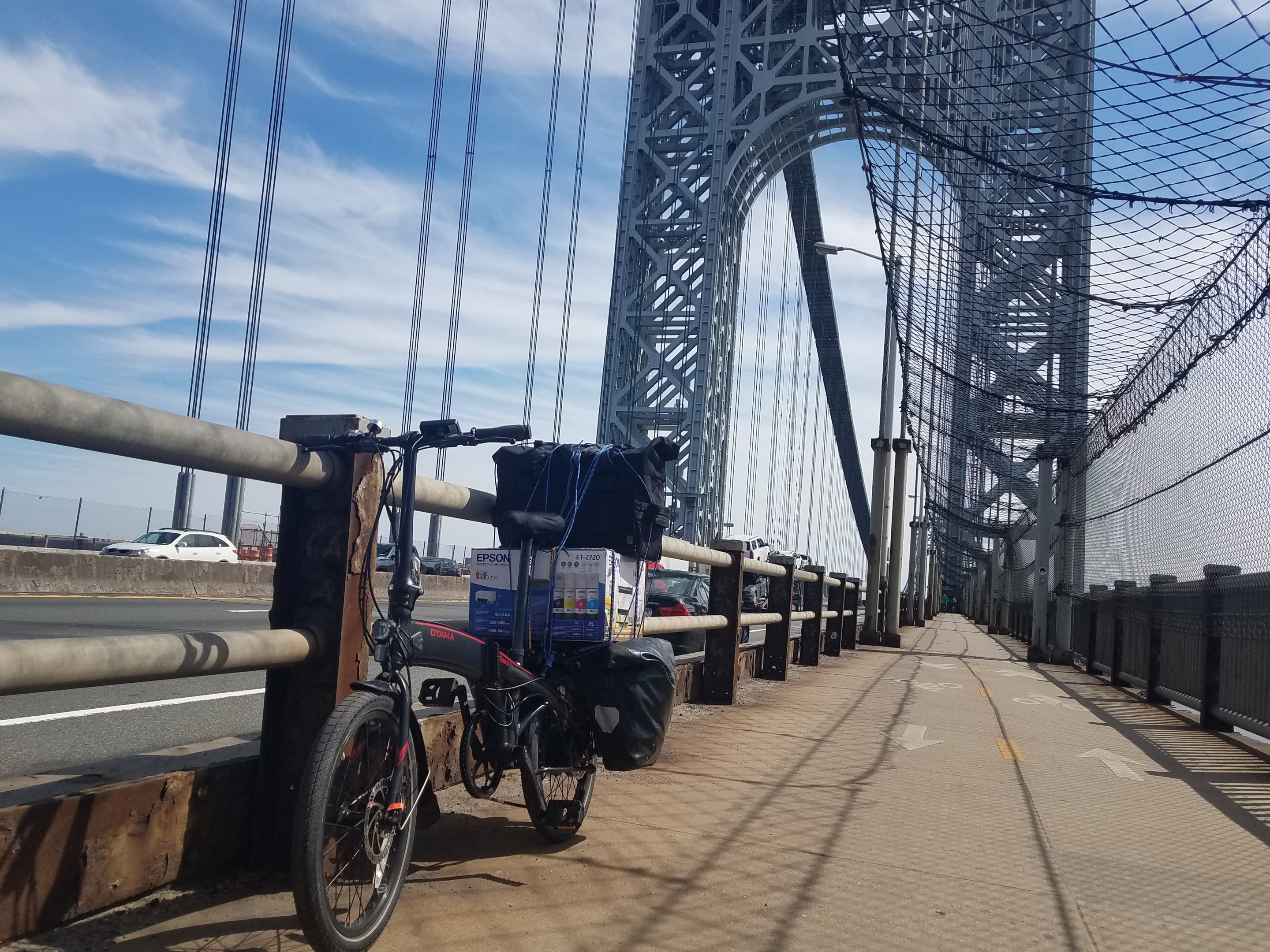Op-Ed: Fix the Flaws in the State’s E-Bike Law
10:25 AM EDT on May 20, 2020

File photo: Dan Suraci
New York State’s new e-bike law represents a big step forward for active transportation that (we hope!) will stop the NYPD's wholesale harassment of e-bike delivery workers and boost commercial sales of electric bikes and cycling more generally. But the legislation contains several key flaws that will create confusion for police, manufacturers and the riding public.
As municipalities across the state apply the law in their jurisdictions, the Legislature should act quickly to fix these flaws — so that we can remove any more excuses to target riders of color and all begin to enjoy the benefits of this promising mobility technology.
E-bikes have a rechargeable, battery-powered electric motor that cyclists can engage either by pedaling or engaging a throttle for a boost of power. The spread of electric pedal assistance likely will encourage many more people to embrace bicycle commuting. Why do New Yorkers need e-bikes? Bicycling is an excellent form of low-impact cardiovascular exercise (and a zero-emission form of transportation) but rugged and/or hilly terrain in the state discourages many would-be riders.
E-bikes also expand bicycle accessibility, especially for aging and differently abled populations — bringing newfound access to parks, trails and bike lanes, all without sacrificing the fitness benefits of bike riding.
Until now, however, ambiguity about e-bikes’ legal status here made it difficult for manufacturers to gain commercial traction. Bike shops hesitated to invest in products that might not be legal to sell while purchasers were leery of buying bikes that could be confiscated.
The new law removes those ambiguities by creating three “classes” of e-bikes: Class 1 are pedal-assist bikes that can reach speeds of 20 miles per hour; Class 2 bikes are controlled by throttle and can reach speeds of 20 mph; and Class 3 bikes are controlled by throttle and can reach speeds of 25 mph. (The state regulates motorized two-wheeled vehicles that can travel at more than 25 mph — such as Vespas or motorbikes — as motorcycles, a separate class of vehicles within the state's Vehicle and Traffic Law.)
What the law gets wrong
The law’s flaws, however, are manifold:
- It has a helmet requirement — but only for Class 3 bikes — a source of confusion for both users and law enforcement.
- It leaves some important regulation of e-bikes (such as where you can ride them) up to individual municipalities — creating yet more confusion.
- It lacks specific bike-labeling and education mandates.
What’s wrong with helmets?
In general, helmet requirements are regressive because they create yet another barrier to cycling without contributing much to safety — ultimately, helmets don't prevent crashes. But the helmet requirement in the new legislation is especially flawed because it lacks consistency among the various classes of e-bikes, creating challenges for users and law enforcement.
Who can tell the difference among these bikes?
The bill requires that manufacturers label e-bikes by listing the class, maximum motor-assisted speed, and wattage on the bike frame. But the location of the label will likely vary based on the size/shape of a bike frame, and may look different depending on the manufacturer. Even the most informed cycling consumers might have difficulty distinguishing one regulatory “class” from the next — so they might not know when they need to wear a helmet.
And forget about the cops! The police — who pretty much lack any training about bicycles — won’t be able to enforce the helmet requirement without pulling riders over. That will invite yet another excuse to harass cyclists, especially delivery workers of color — which the e-bike law was designed in part to prevent.
Municipal madness
Yet the more fundamental flaw in the legislation is its delegation of whether and/or where one can operate an e-bike to individual municipalities. Municipalities can "opt in" and choose to allow any or all three classes of bike to operate in their jurisdictions — or they can "opt out" and allow none — and can choose to allow the bikes only on selected streets or off-road corridors.
Municipalities have some legitimate safety concerns about e-bikes — especially Class 3 models that can reach higher speeds — but Class 1 pedal-assist bikes should not be subject to local regulation. Imagine riding an e-bike on one of many trails between the Bronx and Westchester County. If the laws differed among New York City, Yonkers, and Mount Vernon, you easily could find yourself with a ticket if you crossed any of these borders (which might not be delineated clearly on wooded trails).
Yet all these issues are easily fixed: The legislature should:
- Eliminate the helmet requirement for Class 3 e-bikes.
- Exempt Class 1 e-bikes — the ones that are most like regular bicycles — from municipal regulation. New Yorkers should be able to ride them everywhere in the state, including trails and on most roads except highways.
- Require more detailed specifications about the placement and design of regulatory stickers, such that they either conform with established industry norms or are integrated into a unified set of Department of Motor Vehicles standards.
- Mandate education strategies and materials for consumers and law enforcement — ideally as part of a broader curriculum around active transportation at the DMV and New York State Police academies.
#Ebikes are pretty cool. Hopefully @AndreaSCousins & @CarlHeastie can fix #NYS' #ebike laws so people outside of NYC can actually use them. https://t.co/TPcIVRXXo2 https://t.co/3AaFEnzs6g
— Bike Tarrytown (@BikeTarrytown) May 11, 2020
When we iron out these wrinkles, New Yorkers will enjoy many positive effects of e-bikes in our state in terms of (fingers crossed!) less over-policing, equitable mobility, accessibility, tourism and local and regional economic development.
Let’s get moving so that e-bikes can become a working component of a greener, more multi-modal transportation landscape.
Dan Suraci (@bikinghero), a certified planner, authored the American Public Transportation Association’s national guide on bicycle and transit integration and is president of Urban Cycling Solutions.
Read More:
Stay in touch
Sign up for our free newsletter
More from Streetsblog New York City
OPINION: Congestion Pricing Will Help My Family Get Around As We Navigate Cancer Treatment
My partner was recently diagnosed with cancer. Congestion pricing will make getting her to treatment faster and easier.
EXCLUSIVE: OMNY Debuts on Fair Fares After Delays
The long-awaited Fair Fares expansion will launch as a three-month pilot for a few dozen riders.
Good Luck Docking Your Citi Bike In Lower Manhattan
Many frustrated commuters to Lower Manhattan opted to simply abandon their Citi Bikes undocked due to the lack of open spots in the area.





